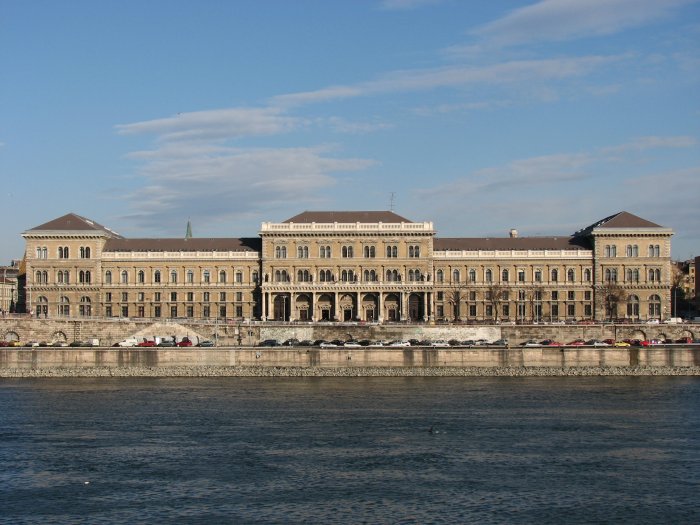The end of the ‘Temporary Stationing’ of Soviet Troops In Hungary

RIA Novosti archive, image #825492 / Miroslav Luzetsky / CC-BY-SA 3.0, CC BY-SA 3.0
The army of the Soviet Union entered Hungarian territory on September 23, 1944 with a claim it was to liberate the country from German occupation. Instead, an operation that was supposedly temporary would only come to an end more than 46 years later.
Soviet tanks leaving Hungary, 1990. Photo by RIA Novosti archive, image #825492 / Miroslav Luzetsky / CC-BY-SA 3.0, CC BY-SA 3.0
The arrival of the Red Army in Hungary in the final phase of World War II was overshadowed by massive destruction and mass rape. After the war was over, Hungary was assigned by the Great Powers to Russia’s sphere of influence.
Accordingly, the presence of Soviet troops was legitimized by the Peace Treaty of Paris of 1947 as it was meant to ensure a smooth supply connection with the invaded Austrian territories.
Keeping two or three divisions, some 20,000-30,000 soldiers, would have sufficed to get the job done; still, some 50,000 men remained.
The Austrian Independence Treaty signed by the Allied occupying powers (France, the United Kingdom, the United States and the USSR) on May 15, 1955 obliged Soviet troops to leave not only Austrian, but also Hungarian territory. That’s not what happened, though.
An addendum to the Warsaw Pact, which was signed one day earlier, established legal ground for the invasion to continue. Furthermore, a special corps was set up from those units that were withdrawn from Austria which, by the summer of 1956, prepared a blueprint for a military operation should it come to an anti-regime revolt.
The legitimacy of the Soviets’ stay at the “invitation” of the host nation was terminated on November 1, 1956 when Prime Minister Imre Nagy declared Hungary’s neutrality. But the Soviet intervention in the events of the 1956 revolution gave another opportunity to bring yet more soldiers onto Hungarian soil.

Portrait of a two soldiers of the Red Army, circa 1945, taken in Budapest. Photo by Oleg Golovnev / Shutterstock.com
Beefed-up
Their beefed-up presence was given legal framework by a treaty between Hungary and the Soviet Union on May 27, 1957 that famously said that the Russian troops were stationed here “on a temporary basis.” There was no talk over how many soldiers were going to be deployed in this fashion, nor for how long, nor was it laid down who would bear the related costs.
Troops were deployed all over the country. Up to 65,000 soldiers were based in 100 garrisons and at 10 air bases. Close to 6,000 buildings were in use. Maintaining such military presence came at a cost, though, the burden of which was starting to become unbearable for the Soviet state budget by the end of the 1980s.
The arms race against the United States was bringing Moscow to its knees, and the Soviet adventure in Afghanistan also took a massive toll, both economically and from the military perspective. So, Soviet leader Mikhail Gorbachev had not much of a choice but to say goodbye to the so-called Brezhnev doctrine that threatened any attempt to leave the Soviet bloc with a military strike. Against this backdrop, Gorbachev’s announcement in the United Nations on December 7, 1988, where he committed to withdraw half a million troops from Eastern Europe, was not that surprising.
Gorbachev’s speech gave the first substantial push towards the actual process of withdrawal. However, the ruling Hungarian Socialist Workers’ Party (MSZMP) had only a partial version in mind at first, and talks in Moscow in March 1989 paved the way for the initial phase of at least that half-hearted solution. Then Hungarian Premier Miklós Németh claims to have brokered a secret deal with Gorbachev about the full withdrawal, clandestine nature of which was intended not to undermine the Soviets’ negotiating position with the Americans, although there is no evidence of such a deal. In fact, it wasn’t until mid-October 1989 when the idea of full withdrawal officially popped up in Moscow for the very first time.
From this point on, things started to gather momentum. The March 15, 1989 demonstration witnessed a speech by “A-list” actor György Cserhalmi, who read aloud the 12 points of the opposition forces, including the demand that the Soviet troops should leave immediately. April 25 saw the first soldiers on their way home. Under the promised concept of partial withdrawal, more than 10,000 men had left by the end of May 1989, and by the end of the year the number had surpassed the 12,000 mark.

Portrait of a Red Army lieutenant and his son, taken circa 1958 in Cegléd. Photo by Oleg Golovnev / Shutterstock.com
Nuclear Retreat
Perhaps just as important was the fact that by October 1989, all Russian nuclear warheads had also been moved back to the USSR. The fact that such weapons were on Hungarian soil at all, and had been since 1963, might well have come as a surprise to much of the Hungarian public, as the presence of the nuclear arsenal was a closely guarded secret.
A special storage facility existed for them in the Nagyvázsony-Tótvázsony area, about 15 km north of Lake Balaton. The weaponary included air-to-surface atomic bombs and nuclear warheads meant for operations on land. Their power was equivalent to hundreds of the bomb dropped on Hiroshima.
Youth liberal party Fidesz organized a protest at the Russian Embassy on June 15 to demand full removal of troops, and the day after Viktor Orbán expressed the same demand in his famous speech at the reburial of Imre Nagy. So the opposition kept pushing for total withdrawal, and did so with reason: a meeting between MSZMP general secretary Károly Grósz and Gorbachev affirmed, yet again, a partial pull back only, even at the end of July 1989.
As months passed by, the apparatchiki slowly switched into realpolitik mode. The collapse of the regime looked more and more inevitable by the day, therefore, they decided to rather to take the lead on the matter.
As Gorbachev’s advisor, Georgy Shakhnazarov put it, the new Hungarian and Polish governments would demand full withdrawal anyway, and it would be better that the withdrawal could take place in dignity, and “we avoid being mocked by our enemies”. The fact that the military presence was designed to deter opposition had clearly become irrelevant by this time, he added.

Studio portrait of a Red Army officer, tank mechanic, taken in Cegléd, circa 1950. The Soviet forces had a tank regiment based in Cegléd, about 70 km southeast of Budapest.
Last Man Standing
The last nail in the coffin of Russian occupation was the Malta Summit between President George Bush and Mikhail Gorbachev on December 2-3, 1989. That’s when the cold war officially ended, and the Soviet Union finally let Eastern Europe go.
The schedule for the Russian withdrawal from Hungary was agreed upon on January 9, 1990. Talks to define the details started soon after, on February 1, 1990 which laid the groundwork for the intergovernmental pact on the matter signed on March 10. Under that pact, the whole process had to be completed by June 30, 1991, and it concerned all military personnel, Soviet civilians, weaponry, and military equipment.
Apart from the total of some 100,000 Soviet citizens, perhaps half of which were civilians, a massive amount of military equipment had to be moved. The operation involved 27,000 military and motor vehicles, 230,000 tonnes of ammunition, 100,000 tonnes of fuel and an additional 230,000 tonnes of other military equipment. Some 35,000 railway wagons were required to transport all that material to the Russian border where they had to be unpacked and reloaded onto Soviet cargo trains because of the different track gauge used.
The last train full of military personnel left Hungary on June 16 (ahead of schedule), while the very last Soviet soldier, commander Viktor Silov, crossed the border at 15:01 on June 19, wearing civilian clothes.
Thus, June 19, 1991 became a key date in Hungarian history: since Germany overthrew the regime of its former ally Miklós Horthy and occupied the country on March 19, 1944, this was the first day when no foreign soldier was stationed on Hungarian soil. To commemorate the occasion, June 19 was declared a “memorial day” of national remembrance (but not a public holiday) by Parliament a decade later in 2001, commemorating the execution of the martyrs of the 1956 Hungarian Revolution (on June 16, 1958), as well as the anniversary of the end of the Soviet occupation of Hungary.
A Bumpy Road to Settlement
Bearing costs turned out to be a major issue during the negotiations over the terms of the withdrawal. Whilst the USSR claimed it had made investments worth some HUF 54 billion, according to the Hungarian estimate damages of up to HUF 88 bln were caused during the invasion. Most of this was environmental pollution, but the property damage was also enormous due to neglected maintenance. At some point, the Russians even threatened to suspend the withdrawal unless the Hungarian government paid up. The parties decided to offset their claims at last which seemingly left the uninvited guests better off. But it wasn’t until the end of 1992 that the actual settlement was finalized and signed. What is more, Hungary committed to provide the Russian military with medical supplies worth USD 10 million, and steps were taken to support the housing of migrating soldiers.
Good Old Days
The withdrawal inspired the local music scene as well, with legendary rock band, Beatrice landing an epic hit called “Azok a boldog szép napok” (“Those good old days”). The song performed by lead singer Feró Nagy is still popular with crowds, with lyrics that declare: “Those good old days, goodbye now / But you just don’t know how great it feels without you / The most beautiful moment is when we say goodbye / And you get on the train / With tears in my eyes I can’t stop thinking about / Don’t you dare to miss it.”
Ruszkik, Haza!
The 1956 revolution had at least two trademark phenomena: the flag with the hole in the middle (the Communist coat of arms was ripped out as an act of protest) and the chant of “Ruszkik, haza!” (Russians, go home!). Both were banned after the suppression of the revolution, of course, and the chanting reemerged only during the heated demonstrations in the very final phase of the change of regime. However, one of the last times the slogan was chanted en masse by passionate Hungarians in public was on April 17, 1991. That day Hungary played the Soviet Union in a qualifier for Euro 1992, the UEFA European Football Championship, at what was then the Népstadion, the national (or People’s) stadium, a game attended by this writer as a youth of 15. Some 60,000 gathered to cheer on the Hungarian national football team, keen to take revenge for the historic loss of 0-6 at the Mexico World Cup of 1986 and symbolically for 45 years of repression. Unfortunately for the script writers, the away team won 1-0, but it didn’t matter. It was still a case of “Tovarishi – konyec” (It’s over, comrades), as a famous political billboard had declared at the first democratic elections one year earlier.
SUPPORT THE BUDAPEST BUSINESS JOURNAL
Producing journalism that is worthy of the name is a costly business. For 27 years, the publishers, editors and reporters of the Budapest Business Journal have striven to bring you business news that works, information that you can trust, that is factual, accurate and presented without fear or favor.
Newspaper organizations across the globe have struggled to find a business model that allows them to continue to excel, without compromising their ability to perform. Most recently, some have experimented with the idea of involving their most important stakeholders, their readers.
We would like to offer that same opportunity to our readers. We would like to invite you to help us deliver the quality business journalism you require. Hit our Support the BBJ button and you can choose the how much and how often you send us your contributions.







